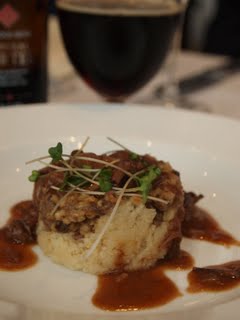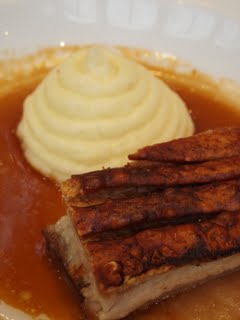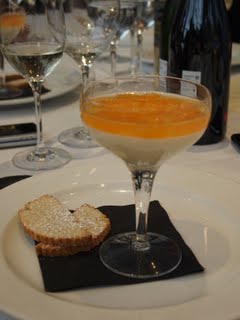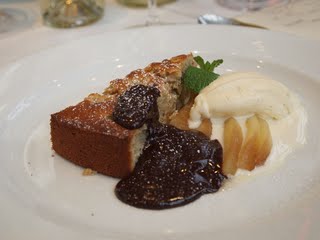 Cruise ships are (floating) terra incognita to me. The closest I’d managed before being offered last weekend’s very lavish freebie was a number of trips on cross-channel ferries, where the food is always so bad you’re almost obliged to pack a picnic; and my friends’ houseboat in Cambridge where we mostly eat packets of biscuits and drink tea.
Cruise ships are (floating) terra incognita to me. The closest I’d managed before being offered last weekend’s very lavish freebie was a number of trips on cross-channel ferries, where the food is always so bad you’re almost obliged to pack a picnic; and my friends’ houseboat in Cambridge where we mostly eat packets of biscuits and drink tea.
I’d imagined cruise ships to be petrol-smelling, slippery-decked, claustrophobic white things, lurching gracelessly between icebergs and tugboats, and occasionally spearing clumsy whales on their prows. “We’ll have bunks,” grumbled Dr W, “and we’ll be in steerage, like Leo Di Caprio. There won’t be any windows.”
Happily, Celebrity Cruises have positioned themselves firmly at the luxury end of the market, so the cabin – sorry, state room – that we’d been apportioned turned out to have king-sized bed with a supremely comfortable pillow-top mattress; thick linen sheets; not only windows, but a private balcony for seagull-spotting; and a shower with those fantastic boob-washing jets in the wall.
 The public areas feel like an attempt at a theme park crossed with a Vegas casino and Terminal 5 at Heathrow. I say this as someone who really, really gets a kick out of Terminal 5, which is sick and wrong – you have to admit, though, that the place does gave a certain delicious gleam to it. On Celebrity Equinox, two glistening atriums stretch the whole height of the ship to relieve the sense of low ceilings you can’t really escape in this situation, one with a live orange tree in a big glass pot suspended halfway down the 14-storey space. Up top, the decks are tiled with swimming pools, hot tubs, lawns, a glass-blowing studio (I’m still scratching my head about this one) and a jogging track. Inside, it’s all state rooms, cafes, bars, restaurants, a spa, a solarium, an enormous theatre, clubs, gyms and an ultraloungy sort of observation suite, all circular couches and swanky LED lighting. Everywhere you turn, somebody dressed in white is washing or polishing something.
The public areas feel like an attempt at a theme park crossed with a Vegas casino and Terminal 5 at Heathrow. I say this as someone who really, really gets a kick out of Terminal 5, which is sick and wrong – you have to admit, though, that the place does gave a certain delicious gleam to it. On Celebrity Equinox, two glistening atriums stretch the whole height of the ship to relieve the sense of low ceilings you can’t really escape in this situation, one with a live orange tree in a big glass pot suspended halfway down the 14-storey space. Up top, the decks are tiled with swimming pools, hot tubs, lawns, a glass-blowing studio (I’m still scratching my head about this one) and a jogging track. Inside, it’s all state rooms, cafes, bars, restaurants, a spa, a solarium, an enormous theatre, clubs, gyms and an ultraloungy sort of observation suite, all circular couches and swanky LED lighting. Everywhere you turn, somebody dressed in white is washing or polishing something.
 Cruises of the sort Celebrity runs are generally all-inclusive, but for the four premium restaurants, where you’ll pay an extra $35. (It’s an American company, and the currency on board is the US dollar.) I’d been invited (with Douglas, Andrew and Julia) to lunch with Chef Jaques Van Staden. We were served a six-course tasting menu with wine pairings in Murano, the ship’s top French restaurant, all dark woods and white linens. Here’s JVS (the chap in focus), beaming at something fatuous I (on the right) have just said.
Cruises of the sort Celebrity runs are generally all-inclusive, but for the four premium restaurants, where you’ll pay an extra $35. (It’s an American company, and the currency on board is the US dollar.) I’d been invited (with Douglas, Andrew and Julia) to lunch with Chef Jaques Van Staden. We were served a six-course tasting menu with wine pairings in Murano, the ship’s top French restaurant, all dark woods and white linens. Here’s JVS (the chap in focus), beaming at something fatuous I (on the right) have just said.
There are constraints on restaurants at sea that I hadn’t even considered before talking to him about the restaurant’s operations. The ship has capacity for 2850 guests, has to feed all these people without recourse to daily markets, and on occasion will go several days without being able to restock. This is an enormous number of people to be feeding – in one year, the company will spend $4.5m on bacon alone, so food sourcing is all centralised. Produce is loaded in shipping containers from three ports around the world, and some clever work on the menus means that the culinary team (of 1253 staff on the ship, more than half work in food and beverage) are able to assemble some surprisingly classy meals which in no way resemble ship’s biscuit. JVS is aiming very, very high in his ambitions for this restaurant, and I’m not quite sure it’s there yet; there were a few slips in what we ate for lunch. But this is a restaurant that’s barely been open for ten days, and as such, there were bound to be a few rough edges that needed smoothing over.
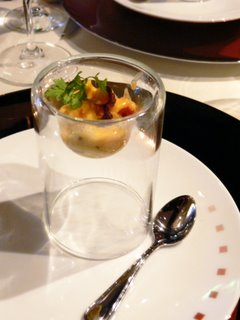 If there’s one thing they’ve licked at Murano, it’s the presentation. Everything was terribly, terribly pretty on the plate; the plates themselves were selected by JVS to match the coppery, woody decor (“No rims. I don’t like a plate with a rim.”) Behold a perfectly pretty amuse – jumbo shrimp in a saffron risotto. Really, really salty, but packed with saffron.
If there’s one thing they’ve licked at Murano, it’s the presentation. Everything was terribly, terribly pretty on the plate; the plates themselves were selected by JVS to match the coppery, woody decor (“No rims. I don’t like a plate with a rim.”) Behold a perfectly pretty amuse – jumbo shrimp in a saffron risotto. Really, really salty, but packed with saffron.
There’s a necessary reliance here on preserved ingredients, so a wild mushroom cappuccino which arrived shortly after I’d spent five minutes banging on about my hatred of foams – oops – used a lot of dried mushrooms and was accompanied by a porcini ice-cream (melting into a small pool by the time it got to my plate, but darned tasty), a clever way to extend the flavour life of the fresh mushroom. The 07 Puligny Montrachet by Louis Jadot with this course was golden and honeyed, a good match with this and, apparently, with the lobster bisque (“Very dense, very flavourful,” said Andrew from Spittoon when I asked him how it was – I have to be careful around lobsters because of the whole anaphylaxis thing, but made up for it by stealing everybody else’s foie gras later in the meal).
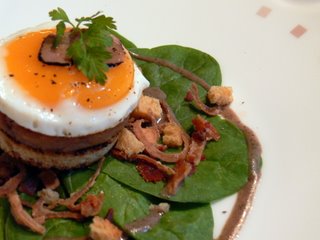 Spinach salad was topped off with a disc of pork rillettes (more clever use of preserves), a chicken’s egg (“I think we should use quail here,” said the chef, frowning at my plate – I’m with him on this – a chicken’s yolk is just too much with something as fatsome as rillettes) and a sliver of black truffle, all scattered with dehydrated shallots and shards of crispy pancetta. Before tasting the dish, I asked JVS how they cope with something as perishable as a truffle at sea. He responded with the full force of his giant grin. “We preserve them in port.” Surprisingly successful, and the truffle vinaigrette was a well-balanced foil to the heavy egg and rillettes. There were a few competition winners from Delicious magazine at the table too, and it was a first taste of truffles for one of them – always a lovely thing to witness, especially when the reaction is so unabashedly positive.
Spinach salad was topped off with a disc of pork rillettes (more clever use of preserves), a chicken’s egg (“I think we should use quail here,” said the chef, frowning at my plate – I’m with him on this – a chicken’s yolk is just too much with something as fatsome as rillettes) and a sliver of black truffle, all scattered with dehydrated shallots and shards of crispy pancetta. Before tasting the dish, I asked JVS how they cope with something as perishable as a truffle at sea. He responded with the full force of his giant grin. “We preserve them in port.” Surprisingly successful, and the truffle vinaigrette was a well-balanced foil to the heavy egg and rillettes. There were a few competition winners from Delicious magazine at the table too, and it was a first taste of truffles for one of them – always a lovely thing to witness, especially when the reaction is so unabashedly positive.
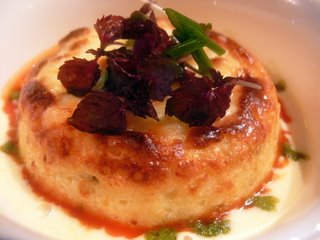 A twice-cooked goat’s cheese soufflé for half of us – a seared slice of foie gras and duck rillettes, spiced with star anise and cinnamon for the others. (I did my best to keep from gazing bitterly at their plates, failed and then launched into stealing as much as I could.) The soufflé was a good one – sharp with the goat’s cheese, bathed in a sea of Parmesan-scented Béchamel – and enormous, such that I ended up eating about half. These are very big portions for a tasting menu. I suspect a lot of this is to do with the demographic that makes up Celebrity’s customers – usually older Americans, from the land where the giant portion is king. That demographic suits me just fine, though – it just means more room in the clubs, the pool and the hot tubs for the food blogging contingent on board while everybody else dozes in the sun, as Andrew has helpfully recorded for posterity.
A twice-cooked goat’s cheese soufflé for half of us – a seared slice of foie gras and duck rillettes, spiced with star anise and cinnamon for the others. (I did my best to keep from gazing bitterly at their plates, failed and then launched into stealing as much as I could.) The soufflé was a good one – sharp with the goat’s cheese, bathed in a sea of Parmesan-scented Béchamel – and enormous, such that I ended up eating about half. These are very big portions for a tasting menu. I suspect a lot of this is to do with the demographic that makes up Celebrity’s customers – usually older Americans, from the land where the giant portion is king. That demographic suits me just fine, though – it just means more room in the clubs, the pool and the hot tubs for the food blogging contingent on board while everybody else dozes in the sun, as Andrew has helpfully recorded for posterity.
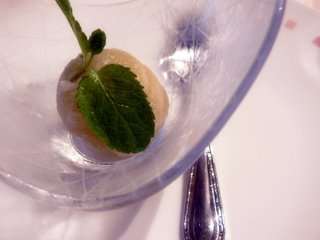 The service is super-attentive; so much so that it all feels a bit unsophisticated, as when the gargantuan pepper grinder is brought out and proffered at the start of every single course. It’s hard to mind – they’re trying so hard to impress, and everybody’s so charming, that I actually missed that grinder when it came to the cheese course. A pretty little apple sorbet spiked with Calvados came out as a palate cleanser – in his review of a similar meal that evening, Jay Rayner called this course old-fashioned, and indeed it was – but it was sweet, it was charming, and it was a nice break from all that dense eating. (I have a soft spot for the concept of a trou Normand, the little hole of space in a full stomach that a gulp of Calvados is meant to give you – my mother used to ensure my little brother and I both got a healthy slurp of hers at large meals when we went on our regular gastronomic tours of France, starting me off on a lifetime of dipsomania.)
The service is super-attentive; so much so that it all feels a bit unsophisticated, as when the gargantuan pepper grinder is brought out and proffered at the start of every single course. It’s hard to mind – they’re trying so hard to impress, and everybody’s so charming, that I actually missed that grinder when it came to the cheese course. A pretty little apple sorbet spiked with Calvados came out as a palate cleanser – in his review of a similar meal that evening, Jay Rayner called this course old-fashioned, and indeed it was – but it was sweet, it was charming, and it was a nice break from all that dense eating. (I have a soft spot for the concept of a trou Normand, the little hole of space in a full stomach that a gulp of Calvados is meant to give you – my mother used to ensure my little brother and I both got a healthy slurp of hers at large meals when we went on our regular gastronomic tours of France, starting me off on a lifetime of dipsomania.)
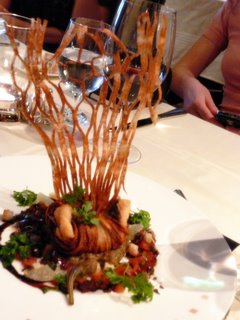 Venison for half the table, loup de mer for the other half. A dense Brunello here to drink – not what I’d have chosen with this fish, but it was a pretty good match with the garnish it was sitting on.
Venison for half the table, loup de mer for the other half. A dense Brunello here to drink – not what I’d have chosen with this fish, but it was a pretty good match with the garnish it was sitting on.
Another hurdle for the cruise ship kitchen to jump is refrigeration – meats and fish need to be frozen. JVS has acquired a machine which defrosts flash-frozen meat very slowly, over a four-day period, for an absolute minimum of cellular damage. The meat is never allowed to stay frozen for more than five days. I pinched a bite from Douglas’s plate (hard work with a fish knife, so I made up for it by also stealing most of his celeriac puree – sorry Douglas) – it’s a surprisingly successful process, and I couldn’t detect any hint that the pink, juicy venison loin had been frozen. Cries of surprise went up around the table from anyone who had ever frozen a steak. Unfortunately, a similar process wouldn’t work for fish, and mine came out of the fryer a bit dry and rubbery. Again, though, the presentation was so fine I almost didn’t care – the fish was trapped in a fine net of potato and served on an incredibly dense and beautiful plate of Provençal preserves – capers, artichokes, olives and so on, bound with raw tomatoes and baba ganoush. (There’s another picture of this very pretty course with Monday’s post, where you can also see some more photos of the ship itself.) Fierce flavours, these – my bread roll came in handy to damp down some of what was going on on the plate.
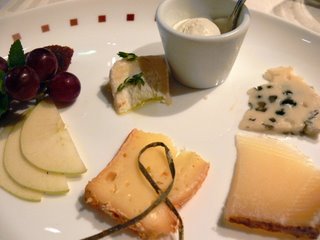 A cheese course next with some ’96 vintage Graham’s port. There was nothing unusual about any of these cheeses, but they were all kept well and chosen well (Epoisses, Livarot, Roquefort, Comte and a nice crottin of Chevre). I notice Jay Rayner was displeased with the texture of his Epoisses that evening – we weren’t given any at lunchtime, although we did see the cheese sitting on the chariot, so I suspect the specialist cheese sommelier (who was great value) secretly agreed with him. The little pot contains a scoop of silky Roquefort sorbet. All the other cheeses, served at a good room temperature with fruits and nuts, were beautiful examples – I am thankful there wasn’t more, because dessert was simply enormous.
A cheese course next with some ’96 vintage Graham’s port. There was nothing unusual about any of these cheeses, but they were all kept well and chosen well (Epoisses, Livarot, Roquefort, Comte and a nice crottin of Chevre). I notice Jay Rayner was displeased with the texture of his Epoisses that evening – we weren’t given any at lunchtime, although we did see the cheese sitting on the chariot, so I suspect the specialist cheese sommelier (who was great value) secretly agreed with him. The little pot contains a scoop of silky Roquefort sorbet. All the other cheeses, served at a good room temperature with fruits and nuts, were beautiful examples – I am thankful there wasn’t more, because dessert was simply enormous.
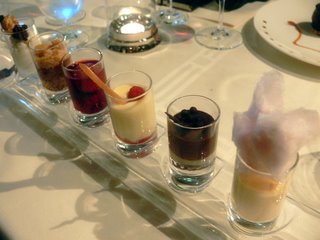 Here it is: Les VI Etoiles du Murano. I think this is meant to serve two, but I ended up with one to myself (which I ended up giving most of to Andrew, the very charming competition winner on my left, while I concentrated on the wine). From right (closest) to left, you’re looking at a rose cream with candyfloss (I annexed that one for myself); a black chocolate and coffee mousse; a white chocolate crème with raspberry coulis (the table’s favourite); strawberries poached in Chambertin; an apple and walnut crumble and a milk and caramel gelato with popcorn. Best of all, though, was what we were given to drink with this course (prompted, I suspect, by the arrival of Celebrity’s president, Dan Hanrahan) – a Tokaji from 2003, a year you will probably remember as uncomfortably sweltering. It was just great for Tokaji, such that I can barely read my handwriting in the notes I took over pudding.
Here it is: Les VI Etoiles du Murano. I think this is meant to serve two, but I ended up with one to myself (which I ended up giving most of to Andrew, the very charming competition winner on my left, while I concentrated on the wine). From right (closest) to left, you’re looking at a rose cream with candyfloss (I annexed that one for myself); a black chocolate and coffee mousse; a white chocolate crème with raspberry coulis (the table’s favourite); strawberries poached in Chambertin; an apple and walnut crumble and a milk and caramel gelato with popcorn. Best of all, though, was what we were given to drink with this course (prompted, I suspect, by the arrival of Celebrity’s president, Dan Hanrahan) – a Tokaji from 2003, a year you will probably remember as uncomfortably sweltering. It was just great for Tokaji, such that I can barely read my handwriting in the notes I took over pudding.
 JVS oversees the menus at all the onboard restaurants – 3786 different dishes are available across the whole ship, and around 12,000 meals and nibbles are served daily. It’s a hell of an operation, and it’s clearly wise of the company to run day-cruises like ours to help the staff learn to cope – this was only day ten of operations, and our evening meal at the much less swanky main dining room was a bit of a let-down after lunchtime’s service. Food in the gargantuan Silhouette dining room was glacially slow in arriving, so our fellow diners had to skip a course to make it to the theatre in time for the show, and the whole table’s main course plates appeared to have missed a crucial pass through a microwave, arriving fridge-cold. Thank God I’d ordered gazpacho for my starter. (I suspect that this is the sort of problem that won’t occur once the ship is up and running properly.) Wines in the complimentary restaurants aren’t good (to be honest,
JVS oversees the menus at all the onboard restaurants – 3786 different dishes are available across the whole ship, and around 12,000 meals and nibbles are served daily. It’s a hell of an operation, and it’s clearly wise of the company to run day-cruises like ours to help the staff learn to cope – this was only day ten of operations, and our evening meal at the much less swanky main dining room was a bit of a let-down after lunchtime’s service. Food in the gargantuan Silhouette dining room was glacially slow in arriving, so our fellow diners had to skip a course to make it to the theatre in time for the show, and the whole table’s main course plates appeared to have missed a crucial pass through a microwave, arriving fridge-cold. Thank God I’d ordered gazpacho for my starter. (I suspect that this is the sort of problem that won’t occur once the ship is up and running properly.) Wines in the complimentary restaurants aren’t good (to be honest,
the white was so awful I ended up drinking Newcastle Brown Ale instead, to the horror of the ladies I was sharing a table with). It’s clear that a cruising foodie needs to be dedicating himself to find that extra $35 a night to eat in one of the five speciality restaurants – and then to spending the rest of the day on the jogging track to burn off all that Béchamel.
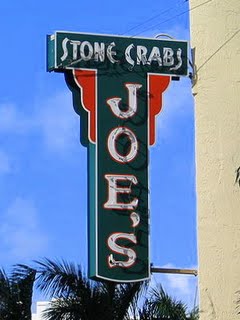 I was, I’ll admit, a bit nervous about the restaurants in Miami. A couple of American friends had told me that they found the food in Florida “unsophisticated” and “boring” – thankfully, this really wasn’t my experience. (Outside the Disney parks, that is, where you will drive yourself mad trying to find something to eat that isn’t a pretzel, a sausage of some sort or a funnel cake.) We found some really interesting, innovative eating in and around Miami – traditional American at Michael’s Genuine, some great tapas with a very individual twist at Sra. Martinez and a simply astonishing bento box at Naoe, which I’ll give its own post later on.
I was, I’ll admit, a bit nervous about the restaurants in Miami. A couple of American friends had told me that they found the food in Florida “unsophisticated” and “boring” – thankfully, this really wasn’t my experience. (Outside the Disney parks, that is, where you will drive yourself mad trying to find something to eat that isn’t a pretzel, a sausage of some sort or a funnel cake.) We found some really interesting, innovative eating in and around Miami – traditional American at Michael’s Genuine, some great tapas with a very individual twist at Sra. Martinez and a simply astonishing bento box at Naoe, which I’ll give its own post later on.I decided to embrace my status as a tourist, and wore the proffered bib. I’m very glad I did – the claws are ready-cracked, but I still managed to spray us both with liberal amounts of butter and crabby juices. A polite notice informed us that the recent cold weather (so aberrant that nobody in town seemed able to talk about anything else for the week we were there) meant that the meat from the claws may stick to the shell. It didn’t, but this is still a messy eat. There’s more here than you’ll be able to eat; be careful to save some room for the excellent pie. The crab is the main event here, and it’s downright fabulous – dense, sweet, rich and full of meat.


